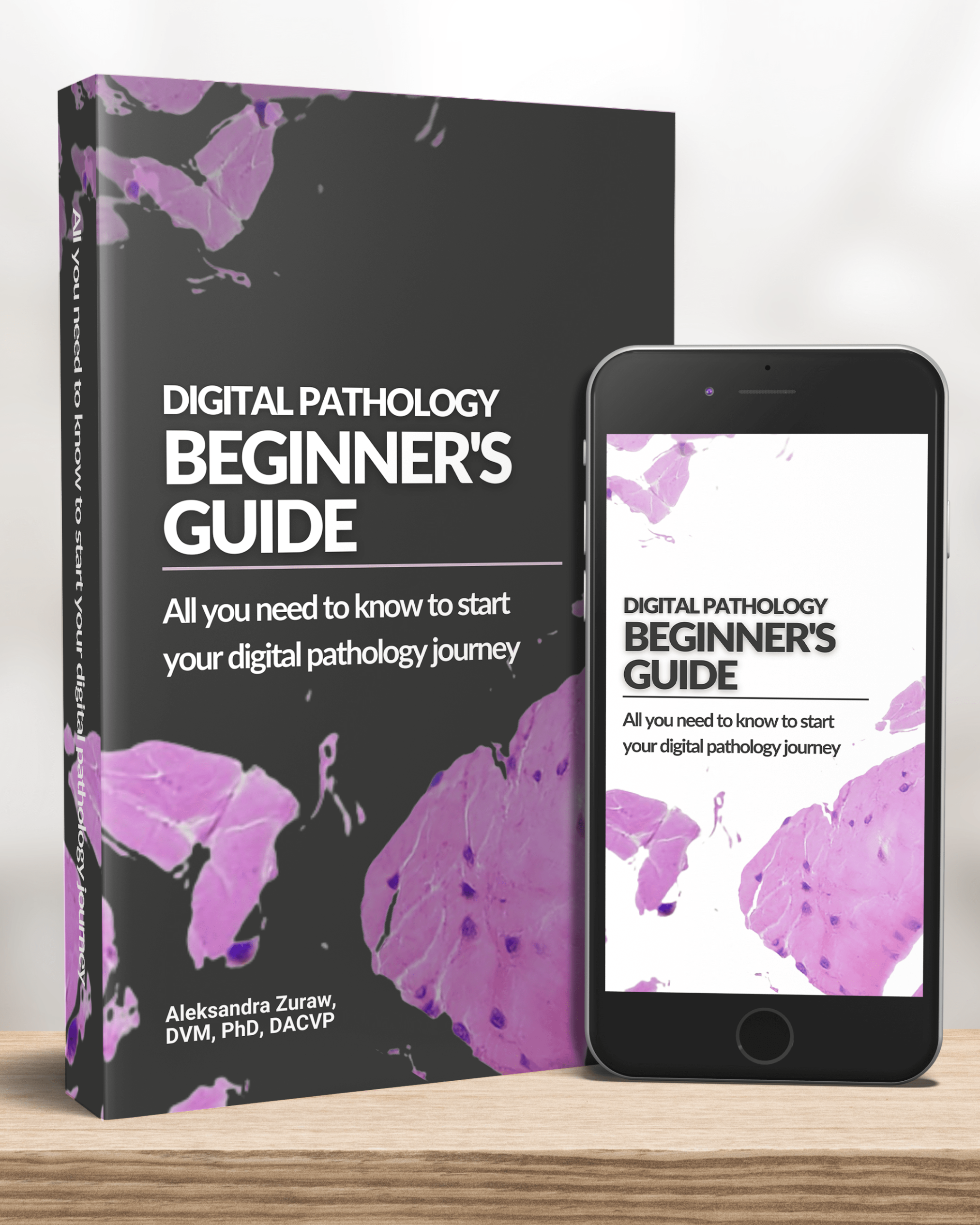Aleks: So before we talk about annual conference that I wanna ask you about, there are two technologies that I would like to ask your opinion on and how do you think they might help or might not help in Asia? One thing is working with static images. So this is something I’ve noticed when I interviewed Dr. Talat Zehra from Pakistan, and she is dedicated to research on doing AI on static images. And basically what she said. There are no resources for scanners, but you can have a camera and you can have a static image. [00:16:00] And now there are algorithms available that have been developed on the whole slide, images from all those scanners, but they can run on static images and that’s something that is a lot more accessible to the diagnosing pathologists.
Do you think this is gonna to pick up, is it already picking up in other countries? Do you see it being used or…
Junya: yeah, I think…
Aleks: Not necessarily AI, but like leveraging static. Images because I think the moment scanners, a couple of years ago, it was all scanner hype, whole slide images. But there are many countries, it’s a prohibitive cost.
Junya: Sure.
Aleks: But digitizing of images, you can basically use your phone. So tell me your, your opinion on that.
Junya: You know what whatever, of course, there’s a difference between the wholesale image and static images. I did the same thing for the static images before I installed the wholesale images.
It is a process. If you don’t have those resources, if you don’t have, the budget, you have to, the, do it, through the. Static image and it’s fine. There should be the time and opportunity for you to install [00:17:00] if you are really willing to, and wishing and hoping and keep negotiating to the, your hospital or government, wherever it always salary away pops up.
And then you’ve just install it. But beforehand how you prepare yourself. Whatever you can do, you cannot just directly jump to the very expensive, scanner at all. But if you’re doing the, those similar things onto the a static image, that’s already the digital pathology. This is a process what we all did, so you know, what she’s doing is not so much different from us.
Yeah. It’s already in process.
Aleks: Another thing that I have witnessed one time in Africa when I visited Ethiopia is something, I don’t know if it’s officially called like that, but like jumping over a technology step, I saw that with the telephones in Africa, so obviously Europe and North America, there were telephone lines, right?
Everybody had the normal line telephones, right? And that was not the case in Africa. They basically didn’t do it. They waited and then suddenly [00:18:00] everybody had cell phones.
Junya: Correct.
Aleks: So they basically skipped this whole mega infrastructure investment because they just didn’t have the resources.
But then. A consumer technology came to play and you said that you just said that, oh, suddenly something appears and you can embark on a journey that like others need to take an intermediate. Step or so, and I see it in digital pathology. I see it with the direct to digital imaging. What I’ve seen, there were several vendors doing either direct fresh tissue imaging, like for example, Muse Microscopy.
There is digital staining from unstained slides. There are like different technologies around making digital images available directly from tissue and basically, skipping the scanner step. What are your thoughts on that?
Junya: That is a very good point. So I would say, those skipping old and complex processes I can say, look at the tissue. We, how we look at, the microscope, we have to fix [00:19:00] it. We will embed it into the paraphin, and just, do the dissection.
Aleks: A lot of work…
Junya: It’s a lot of work and also a lot of those work has to have highly skilled humans, yeah.
Which is very difficult to have as a resources. And those poor resource country, they don’t have it. Then the internet, it’s the same story as you said, for the smartphone. They can skip it, just go directly, go jump to the pseudo. Know H&E created from like a Muse you said,
Aleks: Yeah. That’s uv. And also UV light, right? Generating the image there is, there are options to generate fluorescent images. But yeah, the Muse one is the device that’s commercially available. I think that’s the most mature right out of the other solutions that they’ve seen.
Junya: There are several others doing similar.
So those, the approach, let’s say one in, in America is with called Phoebe. It’s also the similar, the approach, whatever the device, use, and you can skip those, processing of the the tissue, to [00:20:00] creating a tissue and also block and then the, but you could, get those images right away.
Aleks: Yeah.
Junya: And that was shortcut the TAT as well.
Aleks: Yeah.
Junya: So those new technology may develop well in the low resource country because of the experience, because they basically don’t have approach to the one we have in laboratory. And they’re like smartphone, it’s happening.
Let’s say, I will give you an example. So inside Asia, before we established a society, we didn’t know much about what’s going on inside Asia. We know after the research among the whole Asian country, who was that there are several country inside Asia who does show very much advance in digital.
Aleks: Yeah.
Junya: Like, in Kuwait, or Saudi Arabia and of course, South Korea. In China…
Aleks: Can you estimate the level of adoption in terms of how many what percentage of hospitals are digital for pathology?
Junya: Yeah. And especially for in Kuwait it’s about 50% [00:21:00].
Aleks: Oh, my goodness half of the,
Junya: See, look at, in the US it’s less than 5%, right?
Let’s say Japan, we started digital pathology very early days. But if you look at, the institution who use digital pathology for the practice. About 1%. Okay. Believe me.
Aleks: So it’s a spread. Yeah. A crazy spread. Like half of the, it is half the hospitals in Kuwait. Amazing. Yeah. So yeah. Diversity again, it is in everything. So how was. The Congress, your annual Congress. I am holding the flyer for the second one. And we’re gonna invite you to the second one, but let’s talk about the first one. When was it?
Junya: It was in this year, October 2nd to fourth.
So we established society this year.
Aleks: a month ago.
Junya: Yeah. Actually the society establishment was in February in Singapore.
But then when we just succeed to open up the bank account is so recent. So we couldn’t get even member,
Aleks: The member due.
Junya: Yeah, exactly. [00:22:00] The whole like gonna say August.
So we have only two months before the onsite event. We got over 400 attendee and all of the 45 booths are sold out.
And actually that attendee came from 29 countries.
Aleks: Oh my goodness.
Junya: Yeah. And the, there was enough.
Aleks: Do you know how many countries are in Asia?
Junya: In Asia? About 50 plus something.
Okay. Yeah. And also, one more thing is that we hit abstract. Application about 90 something, 91, I believe.
Aleks: Oh my goodness. Almost a hundred abstracts.
Junya: Yes. For the first year.
Aleks: This is amazing.
Junya: And we did rebuild old the abstract and decide which one to go to the, or the stuff. And to figure out most of the science level was quite high.
It’s almost equivalent. Maybe some are even better. Than the one we see in America, Europe. That’s…
Aleks: This is amazing.
Junya: You know that we didn’t know that, we had many talented people, almost like a superstar in this field. But we didn’t know each other because they’re going to America [00:23:00] and Europe to attend to the meeting. So we have no network. We didn’t know anybody, inside Asia. But now we start knowing each other, start making network. And this network is a source. Of the old, the new idea, brainstorming. Now you get an idea how we would contribute to this field.
Aleks: This is amazing. Basically, unifying all those people and like getting all those developments in one place and the success of your first meeting, like 400 on your first that you like gathered in the less than half a year.
It just speaks for the need of a specific Asian society. And now with the networking, your guys are gonna grow exponentially and it’s gonna be amazing. I’m so happy for you.
Junya: Thank you.














